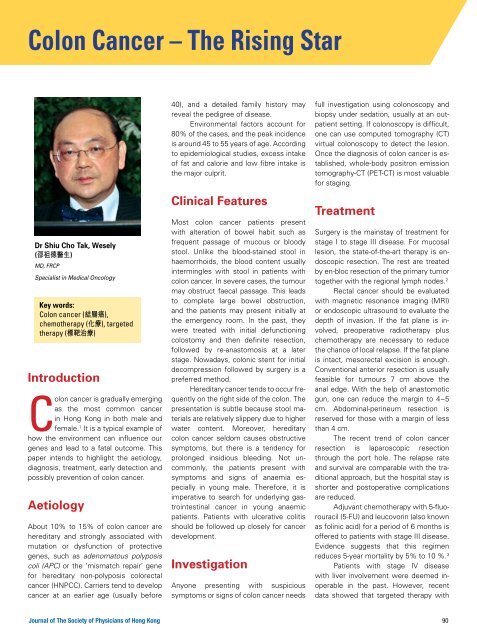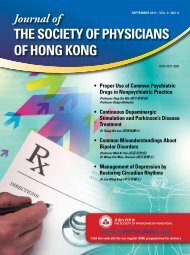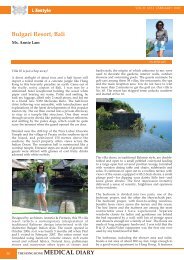the Society of Physicians of Hong Kong
THE SOCIETY OF PHYSICIANS OF HONG KONG
THE SOCIETY OF PHYSICIANS OF HONG KONG
- No tags were found...
Create successful ePaper yourself
Turn your PDF publications into a flip-book with our unique Google optimized e-Paper software.
Colon Cancer – The Rising Star<br />
Dr Shiu Cho Tak, Wesely<br />
( 邵 祖 德 醫 生 )<br />
MD, FRCP<br />
Specialist in Medical Oncology<br />
Key words:<br />
Colon cancer ( 結 腸 癌 ),<br />
chemo<strong>the</strong>rapy ( 化 療 ), targeted<br />
<strong>the</strong>rapy ( 標 靶 治 療 )<br />
Introduction<br />
Colon cancer is gradually emerging<br />
as <strong>the</strong> most common cancer<br />
in <strong>Hong</strong> <strong>Kong</strong> in both male and<br />
female. 1 It is a typical example <strong>of</strong><br />
how <strong>the</strong> environment can influence our<br />
genes and lead to a fatal outcome. This<br />
paper intends to highlight <strong>the</strong> aetiology,<br />
diagnosis, treatment, early detection and<br />
possibly prevention <strong>of</strong> colon cancer.<br />
Aetiology<br />
About 10% to 15% <strong>of</strong> colon cancer are<br />
hereditary and strongly associated with<br />
mutation or dysfunction <strong>of</strong> protective<br />
genes, such as adenomatous polyposis<br />
coli (APC) or <strong>the</strong> ‘mismatch repair’ gene<br />
for hereditary non-polyposis colorectal<br />
cancer (HNPCC). Carriers tend to develop<br />
cancer at an earlier age (usually before<br />
40), and a detailed family history may<br />
reveal <strong>the</strong> pedigree <strong>of</strong> disease.<br />
Environmental factors account for<br />
80% <strong>of</strong> <strong>the</strong> cases, and <strong>the</strong> peak incidence<br />
is around 45 to 55 years <strong>of</strong> age. According<br />
to epidemiological studies, excess intake<br />
<strong>of</strong> fat and calorie and low fibre intake is<br />
<strong>the</strong> major culprit.<br />
Clinical Features<br />
Most colon cancer patients present<br />
with alteration <strong>of</strong> bowel habit such as<br />
frequent passage <strong>of</strong> mucous or bloody<br />
stool. Unlike <strong>the</strong> blood-stained stool in<br />
haemorrhoids, <strong>the</strong> blood content usually<br />
intermingles with stool in patients with<br />
colon cancer. In severe cases, <strong>the</strong> tumour<br />
may obstruct faecal passage. This leads<br />
to complete large bowel obstruction,<br />
and <strong>the</strong> patients may present initially at<br />
<strong>the</strong> emergency room. In <strong>the</strong> past, <strong>the</strong>y<br />
were treated with initial defunctioning<br />
colostomy and <strong>the</strong>n definite resection,<br />
followed by re-anastomosis at a later<br />
stage. Nowadays, colonic stent for initial<br />
decompression followed by surgery is a<br />
preferred method.<br />
Hereditary cancer tends to occur frequently<br />
on <strong>the</strong> right side <strong>of</strong> <strong>the</strong> colon. The<br />
presentation is subtle because stool materials<br />
are relatively slippery due to higher<br />
water content. Moreover, hereditary<br />
colon cancer seldom causes obstructive<br />
symptoms, but <strong>the</strong>re is a tendency for<br />
prolonged insidious bleeding. Not uncommonly,<br />
<strong>the</strong> patients present with<br />
symptoms and signs <strong>of</strong> anaemia especially<br />
in young male. Therefore, it is<br />
imperative to search for underlying gastrointestinal<br />
cancer in young anaemic<br />
patients. Patients with ulcerative colitis<br />
should be followed up closely for cancer<br />
development.<br />
Investigation<br />
Anyone presenting with suspicious<br />
symptoms or signs <strong>of</strong> colon cancer needs<br />
full investigation using colonoscopy and<br />
biopsy under sedation, usually at an outpatient<br />
setting. If colonoscopy is difficult,<br />
one can use computed tomography (CT)<br />
virtual colonoscopy to detect <strong>the</strong> lesion.<br />
Once <strong>the</strong> diagnosis <strong>of</strong> colon cancer is established,<br />
whole-body positron emission<br />
tomography-CT (PET-CT) is most valuable<br />
for staging.<br />
Treatment<br />
Surgery is <strong>the</strong> mainstay <strong>of</strong> treatment for<br />
stage I to stage III disease. For mucosal<br />
lesion, <strong>the</strong> state-<strong>of</strong>-<strong>the</strong>-art <strong>the</strong>rapy is endoscopic<br />
resection. The rest are treated<br />
by en-bloc resection <strong>of</strong> <strong>the</strong> primary tumor<br />
toge<strong>the</strong>r with <strong>the</strong> regional lymph nodes. 2<br />
Rectal cancer should be evaluated<br />
with magnetic resonance imaging (MRI)<br />
or endoscopic ultrasound to evaluate <strong>the</strong><br />
depth <strong>of</strong> invasion. If <strong>the</strong> fat plane is involved,<br />
preoperative radio<strong>the</strong>rapy plus<br />
chemo<strong>the</strong>rapy are necessary to reduce<br />
<strong>the</strong> chance <strong>of</strong> local relapse. If <strong>the</strong> fat plane<br />
is intact, mesorectal excision is enough.<br />
Conventional anterior resection is usually<br />
feasible for tumours 7 cm above <strong>the</strong><br />
anal edge. With <strong>the</strong> help <strong>of</strong> anastomotic<br />
gun, one can reduce <strong>the</strong> margin to 4−5<br />
cm. Abdominal-perineum resection is<br />
reserved for those with a margin <strong>of</strong> less<br />
than 4 cm.<br />
The recent trend <strong>of</strong> colon cancer<br />
resection is laparoscopic resection<br />
through <strong>the</strong> port hole. The relapse rate<br />
and survival are comparable with <strong>the</strong> traditional<br />
approach, but <strong>the</strong> hospital stay is<br />
shorter and postoperative complications<br />
are reduced.<br />
Adjuvant chemo<strong>the</strong>rapy with 5-fluorouracil<br />
(5-FU) and leucovorin (also known<br />
as folinic acid) for a period <strong>of</strong> 6 months is<br />
<strong>of</strong>fered to patients with stage III disease.<br />
Evidence suggests that this regimen<br />
reduces 5-year mortality by 5% to 10 %. 3<br />
Patients with stage IV disease<br />
with liver involvement were deemed inoperable<br />
in <strong>the</strong> past. However, recent<br />
data showed that targeted <strong>the</strong>rapy with<br />
Journal <strong>of</strong> The <strong>Society</strong> <strong>of</strong> <strong>Physicians</strong> <strong>of</strong> <strong>Hong</strong> <strong>Kong</strong> 90








